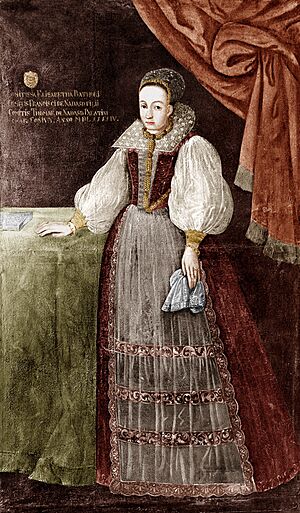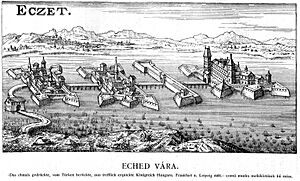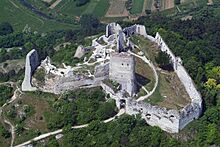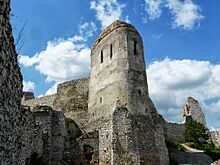Elizabeth Báthory facts for kids
Quick facts for kids
Elizabeth Báthory
|
|
|---|---|

Elizabeth Báthory
|
|
| Born |
Báthori Erzsébet
7 August 1560 Nyírbátor, Kingdom of Hungary
|
| Died | 21 August 1614 (aged 54) Csejte, Kingdom of Hungary
(now Čachtice, Slovakia) |
| Other names | Bloody Countess |
| Known for | Hungarian noblewoman, subject of folklore |
| Spouse(s) | Ferenc II Nádasdy |
| Relatives |
|
| Family | Báthory |
Countess Elizabeth Báthory de Ecsed (Hungarian: Báthori Erzsébet Slovak: Alžbeta Bátoriová; 7 August 1560 – 21 August 1614) was a Hungarian noblewoman. She came from the powerful Báthory family. They owned a lot of land in the Kingdom of Hungary, which is now part of Slovakia.
Elizabeth Báthory and four of her helpers were accused of harming many people between 1590 and 1610. Her helpers were put on trial and found guilty. However, Báthory herself was kept prisoner inside Csejte Castle. She died there under unclear circumstances.
Some historians believe the accusations against Báthory were part of a "witch-hunt." This means people might have been looking for someone to blame. Other writers say that over 300 people gave statements against her. More recent ideas suggest the accusations were a way to reduce her family's power. Her family's influence was seen as a threat to other powerful people, like the Habsburg empire.
Stories about Báthory quickly became popular folklore. Some people think she inspired Bram Stoker's famous book Dracula (1897). But there is no direct proof in Stoker's notes to support this idea.
Contents
Biography
Early Life and Family
Elizabeth Báthory was born in 1560. Her family lived on a large estate in Nyírbátor, in what was then Royal Hungary. She spent her childhood at Ecsed Castle.
Her father was Baron George VI Báthory. Her mother was Baroness Anna Báthory. Elizabeth came from a very important and wealthy family. Her uncle, Stephen Báthory, became the King of Poland. She had several brothers and sisters. Her older brother, Stephen, became a high-ranking judge in Hungary.
Elizabeth was raised as a Calvinist Protestant. She learned several languages when she was young, including Latin, German, Hungarian, and Greek. Because she was born into a rich noble family, she had a lot of money, a good education, and a high social standing.
As a child, Elizabeth sometimes had seizures. These might have been caused by epilepsy. At that time, people called these symptoms "falling sickness."
Marriage and Estates
In 1573, Elizabeth Báthory became engaged to Count Ferenc Nádasdy. This was an arranged marriage, which was common among noble families. It helped to strengthen their families' power and connections.
They were married on 8 May 1575, at a palace in Varannó (now Vranov nad Topľou, Slovakia). Their marriage meant they owned land in both Transylvania and the Kingdom of Hungary.
As a wedding gift, Nádasdy gave Elizabeth Csejte Castle. This castle was located in the Little Carpathians mountains. It also came with a country house and seventeen nearby villages. After their wedding, the couple lived in Nádasdy's castle at Sárvár.
In 1578, Nádasdy became a chief commander. He led Hungarian troops in a war against the Ottomans. During the war, Elizabeth managed their family's many estates. This was a big job. She was in charge of the Hungarian and Slovak people living on their lands. She also helped provide medical care during the Long War (1593–1606). Elizabeth was also responsible for defending her husband's estates. These lands were often in danger of attack from the Ottomans.
Elizabeth and Ferenc had several children. Their daughter, Anna Nádasdy, was born in 1585. Other children included Orsolya, Katalin, András, and Pál. All of Elizabeth's children were looked after by governesses, just as she had been.
Ferenc Nádasdy died on 4 January 1604, when he was 48 years old. He had been married to Elizabeth for 29 years. Before he died, Nádasdy asked György Thurzó to look after his family and lands. Thurzó would later lead the investigation into Elizabeth Báthory.
Accusations and Arrest

Between 1602 and 1604, stories about Elizabeth Báthory's bad deeds began to spread. A church leader named István Magyari complained about her. In 1610, King Matthias II asked György Thurzó, a high-ranking official in Hungary, to investigate.
Thurzó sent two notaries to gather information in March 1610. By October 1610, they had collected statements from 52 witnesses. By 1611, more than 300 people had given their accounts.
On New Year's Eve in 1612, Thurzó went to Csejte Castle. He arrested Elizabeth Báthory and four of her helpers: Dorotya Semtész, Ilona Jó, Katarína Benická, and János Újváry.
The accusations against Elizabeth were mostly based on these stories and rumours. There are no official records from that time showing that people in the area complained about the Countess. If someone was harmed or even if a chicken was stolen, people usually wrote a formal letter of complaint. Two trials were held for Báthory's helpers in January 1611.
During the trials of her helpers, some people claimed that a servant girl said Báthory's court official had seen a number of 650 victims in one of Báthory's private books. However, this book was never found, and the official himself never mentioned it in his own statement. So, this high number of victims is often questioned.
Imprisonment and Death
On 25 January 1611, Thurzó wrote to King Matthias. He explained that Elizabeth Báthory had been captured and was being held in her castle. She remained imprisoned in Csejte Castle for the rest of her life. She died there at the age of 54.
György Thurzó wrote that Elizabeth Báthory was locked in a room made of bricks. But other old documents suggest she could move around the castle freely. This was more like being under house arrest.
Elizabeth wrote a will in September 1610. In it, she left all her property to her children. In the last month of 1610, she also signed an agreement to divide her estates and lands among her children.
On the evening of 20 August 1614, Báthory told her bodyguard that her hands felt cold. He told her to go to sleep. She was found dead the next morning.
She was buried in the church of Csejte on 25 November 1614. But some stories say that the villagers were upset about her being buried in their cemetery. So, her body was supposedly moved to her birth home at Ecsed. There, it was buried in the Báthory family crypt. Today, no one knows exactly where her body is. It is thought to be buried deep within the church area of the castle. Neither the Csejte church nor Csejte castle has any markers for her grave.
Ancestry
Elizabeth Báthory came from a long line of important noble families. Her ancestors included dukes and other powerful figures from different parts of Europe.
| Ancestors of Elizabeth Báthory | |||||||||||||||||||||||||||||||||||||||||||||||||||||||||||||||||||||||||||||||||||||||||||||||||||||||||||||||||||||||||||||||||||||||||||||||||||||||||||||||||||||||||||||||||||||||||||||||||||||||||||||||||||||||||||||||||||||||||||||||||||||||||||||||||||||||||||||||||||||||||
|---|---|---|---|---|---|---|---|---|---|---|---|---|---|---|---|---|---|---|---|---|---|---|---|---|---|---|---|---|---|---|---|---|---|---|---|---|---|---|---|---|---|---|---|---|---|---|---|---|---|---|---|---|---|---|---|---|---|---|---|---|---|---|---|---|---|---|---|---|---|---|---|---|---|---|---|---|---|---|---|---|---|---|---|---|---|---|---|---|---|---|---|---|---|---|---|---|---|---|---|---|---|---|---|---|---|---|---|---|---|---|---|---|---|---|---|---|---|---|---|---|---|---|---|---|---|---|---|---|---|---|---|---|---|---|---|---|---|---|---|---|---|---|---|---|---|---|---|---|---|---|---|---|---|---|---|---|---|---|---|---|---|---|---|---|---|---|---|---|---|---|---|---|---|---|---|---|---|---|---|---|---|---|---|---|---|---|---|---|---|---|---|---|---|---|---|---|---|---|---|---|---|---|---|---|---|---|---|---|---|---|---|---|---|---|---|---|---|---|---|---|---|---|---|---|---|---|---|---|---|---|---|---|---|---|---|---|---|---|---|---|---|---|---|---|---|---|---|---|---|---|---|---|---|---|---|---|---|---|---|---|---|---|---|---|---|---|---|---|---|---|---|---|---|---|---|---|---|---|---|---|---|
|
|||||||||||||||||||||||||||||||||||||||||||||||||||||||||||||||||||||||||||||||||||||||||||||||||||||||||||||||||||||||||||||||||||||||||||||||||||||||||||||||||||||||||||||||||||||||||||||||||||||||||||||||||||||||||||||||||||||||||||||||||||||||||||||||||||||||||||||||||||||||||
See also
 In Spanish: Erzsébet Báthory para niños
In Spanish: Erzsébet Báthory para niños
- Elizabeth Branch
- Elizabeth Brownrigg
- Kateřina of Komárov
- Delphine LaLaurie
- Catalina de los Ríos y Lisperguer
- Darya Nikolayevna Saltykova





